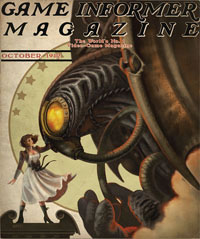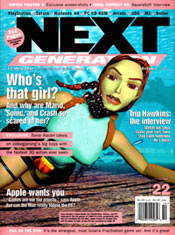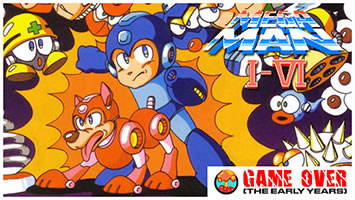- CLASSIC MAGAZINES
- REVIEW CREW
A show recapping what critics thought back
when classic games first came out! - NEXT GENERATION'S BEST & WORST
From the worst 1-star reviews to the best
5-stars can offer, this is Next Generation! - NINTENDO POWER (ARCHIVE)
Experience a variety of shows looking at the
often baffling history of Nintendo Power! - MAGAZINE RETROSPECTIVE
We're looking at the absolutely true history of
some of the most iconic game magazines ever! - SUPER PLAY'S TOP 600
The longest and most ambitious Super NES
countdown on the internet! - THEY SAID WHAT?
Debunking predictions and gossip found
in classic video game magazines! - NEXT GENERATION UNCOVERED
Cyril is back in this spin-off series, featuring the
cover critic review the art of Next Generation! - HARDCORE GAMER MAGAZING (PDF ISSUES)
Download all 36 issues of Hardcore Gamer
Magazine and relive the fun in PDF form!
- REVIEW CREW
- ELECTRONIC GAMING MONTHLY
- ELECTRONIC GAMING MONTHLY RANKS
From Mario to Sonic to Street Fighter, EGM
ranks classic game franchises and consoles! - ELECTRONIC GAMING MONTHLY BEST & WORST
Counting down EGM’s best and worst reviews
going year by year, from 1989 – 2009! - ELECTRONIC GAMING BEST & WORST AWARDS
11-part video series chronicling the ups and
downs of EGM’s Best & Worst Awards!
- ELECTRONIC GAMING MONTHLY RANKS
- GAME HISTORY
- GAME OVER: STORY BREAKDOWNS
Long-running series breaking down game
stories and analyzing their endings! - A BRIEF HISTORY OF GAMING w/ [NAME HERE]
Real history presented in a fun and pithy
format from a variety of game historians! - THE BLACK SHEEP
A series looking back at the black sheep
entries in popular game franchises! - INSTANT EXPERT
Everything you could possibly want to know
about a wide variety of gaming topics! - FREEZE FRAME
When something familiar happens in the games
industry, we're there to take a picture! - I'VE GOT YOUR NUMBER
Learn real video game history through a series
of number-themed episodes, starting at zero! - GREAT MOMENTS IN BAD ACTING
A joyous celebration of some of gaming's
absolute worst voice acting!
- GAME OVER: STORY BREAKDOWNS
- POPULAR SHOWS
- DG NEWS w/ LORNE RISELEY
Newsman Lorne Riseley hosts a regular
series looking at the hottest gaming news! - REVIEW REWIND
Cyril replays a game he reviewed 10+ years
ago to see if he got it right or wrong! - ON-RUNNING FEUDS
Defunct Games' longest-running show, with
editorials, observations and other fun oddities! - DEFUNCT GAMES QUIZ (ARCHIVE)
From online quizzes to game shows, we're
putting your video game knowledge to the test!- QUIZ: ONLINE PASS
Take a weekly quiz to see how well you know
the news and current gaming events! - QUIZ: KNOW THE GAME
One-on-one quiz show where contestants
find out if they actually know classic games! - QUIZ: THE LEADERBOARD
Can you guess the game based on the classic
review? Find out with The Leaderboard!
- QUIZ: ONLINE PASS
- DEFUNCT GAMES VS.
Cyril and the Defunct Games staff isn't afraid
to choose their favorite games and more! - CYRIL READS WORLDS OF POWER
Defunct Games recreates classic game
novelizations through the audio book format!
- DG NEWS w/ LORNE RISELEY
- COMEDY
- GAME EXPECTANCY
How long will your favorite hero live? We crunch
the numbers in this series about dying! - VIDEO GAME ADVICE
Famous game characters answer real personal
advice questions with a humorous slant! - FAKE GAMES: GUERILLA SCRAPBOOK
A long-running series about fake games and
the people who love them (covers included)! - WORST GAME EVER
A contest that attempts to create the worst
video game ever made, complete with covers! - LEVEL 1 STORIES
Literature based on the first stages of some
of your favorite classic video games! - THE COVER CRITIC
One of Defunct Games' earliest shows, Cover
Critic digs up some of the worst box art ever! - COMMERCIAL BREAK
Take a trip through some of the best and
worst video game advertisements of all time! - COMIC BOOK MODS
You've never seen comics like this before.
A curious mix of rewritten video game comics!
- GAME EXPECTANCY
- SERIES ARCHIVE
- NINTENDO SWITCH ONLINE ARCHIVE
A regularly-updated list of every Nintendo
Switch Online release, plus links to review! - PLAYSTATION PLUS CLASSIC ARCHIVE
A comprehensive list of every PlayStation
Plus classic release, including links! - RETRO-BIT PUBLISHING ARCHIVE
A regularly-updated list of every Retro-Bit
game released! - REVIEW MARATHONS w/ ADAM WALLACE
Join critic Adam Wallace as he takes us on a
classic review marathon with different themes!- DEFUNCT GAMES GOLF CLUB
Adam Wallace takes to the links to slice his way
through 72 classic golf game reviews! - 007 IN PIXELS
Adam Wallace takes on the world's greatest spy
as he reviews 15 weeks of James Bond games! - A SALUTE TO VAMPIRES
Adam Wallace is sinking his teeth into a series
covering Castlevania, BloodRayne and more! - CAPCOM'S CURSE
Adam Wallace is celebrating 13 days of Halloween
with a line-up of Capcom's scariest games! - THE FALL OF SUPERMAN
Adam Wallace is a man of steel for playing
some of the absolute worst Superman games! - THE 31 GAMES OF HALLOWEEN
Adam Wallace spends every day of October afraid
as he reviews some of the scariest games ever! - 12 WEEKS OF STAR TREK
Adam Wallace boldly goes where no critic has
gone before in this Star Trek marathon!
- DEFUNCT GAMES GOLF CLUB
- DAYS OF CHRISTMAS (ARCHIVE)
Annual holiday series with themed-episodes
that date all the way back to 2001!- 2015: 30 Ridiculous Retro Rumors
- 2014: 29 Magazines of Christmas
- 2013: 29 Questionable Power-Ups of Christmas
- 2012: 34 Theme Songs of Christmas
- 2011: 32 Game Endings of Christmas
- 2010: 31 Bonus Levels of Christmas
- 2009: 30 Genres of Christmas
- 2008: 29 Controls of Christmas
- 2007: 34 Cliches of Christmas
- 2006: 33 Consoles of Christmas
- 2005: 32 Articles of Christmas
- 2004: 31 Websites of Christmas
- 2003: 29 Issues of Christmas
- 2002: 28 Years of Christmas
- 2001: 33 Days of Christmas
- NINTENDO SWITCH ONLINE ARCHIVE
- REVIEW ARCHIVE
- FULL ARCHIVE
When Did Classic Gaming Magazines Get Their First Cover Girl?
Women had it rough in the 8- and 16-bit era. While it's easy to point to Metroid's Samus Aran or Alis from Phantasy Star, it's clear that the early days of video gaming was largely a boy's club. Female characters were often treated as the prize, while the male hero ventured off to save the day and prove their manhood. This meant that women in retro games were rarely seen or heard from, and even when they were, most female characters were under-developed.
But were classic video game magazines as unbalanced as the industry they were attempting to cover? Is it possible that print media -- which has a long tradition of using attractive women to sell issues -- would buck the trend? Curious by the question, I decided to dig through a dozen old school magazines to see how long it took each to feature a woman on the cover. Big, small, pixel or artwork, all I'm looking for is a cover that features something other than a man. See for yourself how Electronic Gaming Monthly, Nintendo Power, Game Informer and other classic magazines fared.











 CLOSING THOUGHTS:
While it's fun to look back at these old magazine covers, we shouldn't read too much into the findings. Sure, it was a sausage fest for many years, but that doesn't make it sexist. They were a product of their time, and that was an era when women didn't play much of a role in video games. They were the prize or some secondary character, rarely the leading star. The balance started to shift as the industry became more mass-market and major publishers began courting gamers of both genders.
CLOSING THOUGHTS:
While it's fun to look back at these old magazine covers, we shouldn't read too much into the findings. Sure, it was a sausage fest for many years, but that doesn't make it sexist. They were a product of their time, and that was an era when women didn't play much of a role in video games. They were the prize or some secondary character, rarely the leading star. The balance started to shift as the industry became more mass-market and major publishers began courting gamers of both genders.
Going into this study, I was convinced that most magazines would opt for the usual video game cliches, such as the damsel in distress. I was pleased to discover that only four of the twelve magazines used this trope, while another four featured the counterbalance -- women locked in battle. There were also three covers where a woman was featured alone, usually staring at the camera. For my money, the most refreshing magazine cover was Super Play. Instead of choosing an action shot or something sexy, the UK magazine decided to go with a simple picture of a boy and girl playing video games together.
Across the board, there were very few women on video game magazine covers in the 1980s and early 90s. On average, there were a dozen men to every female character. Regardless of whether this is a problem associated with the magazines or the video game industry at large, it's a shame it took so long to notice women in games.
But were classic video game magazines as unbalanced as the industry they were attempting to cover? Is it possible that print media -- which has a long tradition of using attractive women to sell issues -- would buck the trend? Curious by the question, I decided to dig through a dozen old school magazines to see how long it took each to feature a woman on the cover. Big, small, pixel or artwork, all I'm looking for is a cover that features something other than a man. See for yourself how Electronic Gaming Monthly, Nintendo Power, Game Informer and other classic magazines fared.

GAME INFORMEROf the twelve magazines I studied, Game Informer was the most disappointing. The long-running publication didn't feature a woman until their thirteenth issue (November/December 1993). After more than two years, Jasmine (Disney's Aladdin) became the first woman featured on a GI cover. Even more depressing, it took the magazine another 11 issues before featuring their second woman (Shadow from Eternal Champions).
Number of Issues = 13

ELECTRONIC GAMING MONTHLYElectronic Gaming Monthly fared better than Game Informer, but it still took the magazine more than half a year before a single woman showed up. Not only does issue 7 feature badass artwork of Mary from Alien Syndrome, but it also goes by a different name: "Top Scores! Video Game Tricks, Codes, and Strategies!" The first proper issue of Electronic Gaming Monthly to feature a woman? Number 11, featuring The Mafat Conspiracy.
Number of Issues = 7

SEGA FORCEOh no, the Princess is in trouble! No, it's not another Aladdin cover, but rather Prince of Persia on Sega Force. Much like Electronic Gaming Monthly, it took this UK magazine more than half a year to feature a woman on their cover. In this case she's in the distance, obscured by our hero's slack jaw and a very bloody sword. It does not go unnoticed that the Princess is only wearing a bra.
Number of Issues = 7

NINTENDO MAGAZINE SYSTEMBucking the annoying damsel in distress trope, Nintendo Magazine System features an attractive young lady who can kick your ass. Meet Kotono, a 19 year old ninja from Kyoto. She's rocking a serious mane and a look that suggests she's about to rip your throat out. This 1993 cover suggests the 16-bit era may be more welcoming to women. This magazine may be more inclusive, but it seems to have come at the price of being able to spell.
Number of Issues = 7

DIE HARD GAME FANThere's a scary dude with a chainsaw, a kid with an ax, toxic waste, a giant baby, zombies and skeletons walking around for no reason. I think you're going to need something stronger than a water gun and fire extinguisher. It doesn't matter if this Die Hard Game Fan cover makes sense, because Zombies Ate My Neighbors is one of my favorite 16-bit games. It may have taken Game Fan six issues to feature a woman on the cover, but it opened the floodgate for many others.
Number of Issues = 6

NEXT GENERATIONTechnically, Sarah Bryant's elbow is visible on Next Generation's first issue. While some may consider that good enough, I have set the bar slightly higher than an elbow. Ironically, it was another Sarah that ended up being the first woman on a cover of Next Generation magazine. This Fade to Black design is featured on the sixth issue, using the irresistible line, "Graphics to die for." We can dispute the validity of that claim, but this is one of the few classic magazines to feature a woman by herself on the cover.
Number of Issues = 6

THE GAMES MACHINEAnd we're back to the damsel in distress. The Games Machine wasn't known for having memorable covers, and this fifth issue is no exception. For reasons I will never understand, this magazine merged The Three Stooges with Rocket Ranger, featuring a sexy woman in a tight sweater and short skirt. Two issues later, The Games Machine featured a woman playing cards in lingerie.
Number of Issues = 5

NINTENDO POWERIt only took Nintendo Power four issues to feature a woman on their cover. Unfortunately, the woman in question is stuck in a coma and requires a strong man (in this case Richard Marx with a lot of netting) to save her. I'm not even convinced that's a real woman in the picture. For what it's worth, it took Nintendo Power twelve more issues before they featured another woman -- Razor from Maniac Mansion. Samus didn't show up until issue 31.
Number of Issues = 4

GAMEPROPeople often forget how great GamePro's covers were in the early years, and this one is no exception. Forget damsel in distress, because this female barbarian is ready to kill a fanged monster with little more than a small dagger and mini-skirt. Best of all, this ferocious woman isn't actually connected to a game. She's certainly not part of Super Mario Land or River City Ransom, and I don't remember Gauntlet on the side of a snowy mountain. GamePro just decided it was time to have a woman on the cover. Cool.
Number of Issues = 4

MEAN MACHINES SEGASpeaking of women that can kick ass, here's Michelle Pfeiffer as Catwoman on the cover of Mean Machines Sega #1. That's right; the magazine's very first issue featured a woman by herself. Even more impressive, it was a Batman Returns cover without Batman. That's almost as bold as her lipstick. Speaking of bold, this debut issue states that it is "The UK's No. 1 Sega Mag." That's what I call optimism.
Number of Issues = 1

SEGA MAGAZINEHere's yet another Sega magazine featuring a woman on the debut cover. And it's not just any woman; it's Shadow from Eternal Champions. With her generous proportions and revealing costume, it's no wonder Shadow was featured on so many magazine covers. Beyond the sexy woman, Sega Magazine chose to attract readers by making hyperbolic statements about mediocre fighting games.
Number of Issues = 1

SUPER PLAYWomen were not exclusive to Sega magazines, as you'll see from this adorable first issue of Super Play. The UK-based magazine features a blonde girl playing games with an a blue-haired boy in the midst of overacting to a loss. Behind them is a pink monster, as well as a very small Link. Also, the TV is floating and I'm pretty sure the boy is wearing Google Glass. I don't know what any of this means, but I think I've been staring at old game magazines for too long.
Number of Issues = 1
Going into this study, I was convinced that most magazines would opt for the usual video game cliches, such as the damsel in distress. I was pleased to discover that only four of the twelve magazines used this trope, while another four featured the counterbalance -- women locked in battle. There were also three covers where a woman was featured alone, usually staring at the camera. For my money, the most refreshing magazine cover was Super Play. Instead of choosing an action shot or something sexy, the UK magazine decided to go with a simple picture of a boy and girl playing video games together.
Across the board, there were very few women on video game magazine covers in the 1980s and early 90s. On average, there were a dozen men to every female character. Regardless of whether this is a problem associated with the magazines or the video game industry at large, it's a shame it took so long to notice women in games.
HOME |
CONTACT |
NOW HIRING |
WHAT IS DEFUNCT GAMES? |
NINTENDO SWITCH ONLINE |
RETRO-BIT PUBLISHING
Retro-Bit |
Switch Planet |
The Halcyon Show |
Same Name, Different Game |
Dragnix |
Press the Buttons
Game Zone Online | Hardcore Gamer | The Dreamcast Junkyard | Video Game Blogger
Dr Strife | Games For Lunch | Mondo Cool Cast | Boxed Pixels | Sega CD Universe | Gaming Trend
Game Zone Online | Hardcore Gamer | The Dreamcast Junkyard | Video Game Blogger
Dr Strife | Games For Lunch | Mondo Cool Cast | Boxed Pixels | Sega CD Universe | Gaming Trend
Copyright © 2001-2025 Defunct Games
All rights reserved. All trademarks are properties of their respective owners.
All rights reserved. All trademarks are properties of their respective owners.


























